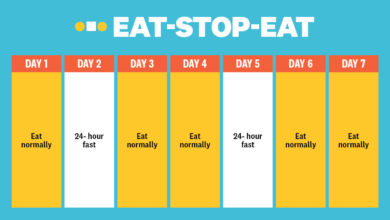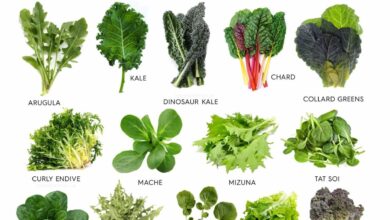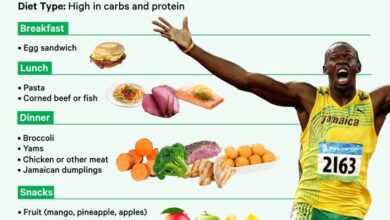
Ask the RD: What Foods Reduce Belly Fat?
Ask the rd what foods reduce belly fat – Ask the RD: What Foods Reduce Belly Fat? We’ve all heard about the stubborn belly fat that just won’t budge, despite our best efforts. It’s not just about aesthetics; excess belly fat can pose serious health risks, increasing the chances of heart disease, type 2 diabetes, and certain cancers.
So, what’s the secret to tackling this stubborn fat? It’s not a quick fix, but with a focus on nutrition, exercise, and lifestyle changes, you can achieve a flatter belly and a healthier you.
This blog post will explore the different types of belly fat, how it accumulates, and most importantly, the foods that can help you shed it. We’ll dive into the science behind these dietary strategies, discussing the role of fiber, protein, and other essential nutrients in promoting satiety and reducing calorie intake.
We’ll also provide practical tips on creating a balanced meal plan and incorporating healthy snacks to keep your cravings in check.
Understanding Belly Fat
Belly fat, also known as visceral fat, is a type of fat that accumulates around your internal organs, including your liver, stomach, and intestines. It’s different from subcutaneous fat, which sits just beneath your skin. While both types of fat contribute to your overall weight, visceral fat is more harmful to your health.
Types of Belly Fat and Their Health Implications
Understanding the different types of belly fat is crucial as they pose varying health risks.
- Visceral fat: This type of fat is stored deep within your abdominal cavity and surrounds your internal organs. It’s linked to an increased risk of chronic diseases like heart disease, type 2 diabetes, and some types of cancer.
- Subcutaneous fat: This fat is located just beneath your skin, which you can pinch. While it’s not as harmful as visceral fat, it can still contribute to health problems if it accumulates excessively.
How Belly Fat Accumulates
The accumulation of belly fat is a complex process influenced by various factors.
- Calorie surplus: When you consume more calories than you burn, your body stores the excess energy as fat. If this excess energy is consistently stored in the abdominal area, it leads to belly fat accumulation.
- Hormonal imbalances: Hormones like cortisol and insulin play a role in fat storage. High levels of cortisol, often associated with stress, can promote belly fat accumulation. Similarly, insulin resistance, where your body doesn’t use insulin effectively, can lead to increased fat storage, particularly in the abdominal region.
- Genetics: Your genes can influence your predisposition to storing fat in your abdomen. Some individuals are genetically more prone to accumulating belly fat compared to others.
- Lack of physical activity: Regular exercise helps burn calories and build muscle, which can contribute to reducing belly fat. Conversely, a sedentary lifestyle can promote fat accumulation, especially in the abdominal area.
- Poor diet: A diet high in processed foods, sugary drinks, and unhealthy fats can contribute to belly fat accumulation. These foods are often calorie-dense and can lead to a calorie surplus, promoting fat storage.
Role of Genetics and Lifestyle Factors
Genetics and lifestyle factors play a significant role in belly fat accumulation.
- Genetics: While your genes can influence your susceptibility to belly fat, they don’t dictate your destiny. You can still manage your belly fat through lifestyle changes.
- Lifestyle factors: Your diet, exercise habits, stress levels, and sleep quality are crucial in determining how much belly fat you accumulate. By adopting a healthy lifestyle, you can significantly influence your belly fat levels.
Dietary Strategies for Reducing Belly Fat
Losing belly fat involves adopting a balanced diet that prioritizes nutrient-rich foods and promotes satiety. This means focusing on foods that keep you feeling full for longer, reducing overall calorie intake, and supporting healthy metabolic processes.
Foods That Promote Satiety
Choosing foods that promote satiety is crucial for reducing belly fat. These foods are rich in fiber, protein, and healthy fats, which help you feel fuller for longer and reduce overall calorie intake.
- High-Fiber Foods:Foods like fruits, vegetables, and whole grains are rich in fiber, which adds bulk to your meals and slows down digestion. This helps you feel full for longer, preventing overeating and reducing calorie intake. Examples include:
- Berries (strawberries, blueberries, raspberries)
- Leafy greens (spinach, kale, romaine lettuce)
- Broccoli
- Avocado
- Whole-grain bread
- Oats
- Beans
- Lentils
- Protein-Rich Foods:Protein helps you feel fuller for longer and promotes muscle mass, which boosts metabolism. Examples include:
- Lean meats (chicken, turkey, fish)
- Eggs
- Dairy products (Greek yogurt, cottage cheese)
- Legumes (beans, lentils)
- Nuts and seeds
- Healthy Fats:Unsaturated fats found in foods like avocados, nuts, and seeds can promote satiety and help regulate hormones that control appetite.
High-Fiber Foods for Belly Fat Reduction
Incorporating high-fiber foods into your diet is essential for reducing belly fat. Fiber plays a crucial role in promoting satiety, regulating blood sugar levels, and improving gut health, all of which contribute to effective weight management.
- Promotes Satiety:High-fiber foods absorb water in the digestive system, creating a feeling of fullness and reducing hunger pangs. This helps control calorie intake and prevents overeating.
- Regulates Blood Sugar Levels:Fiber slows down the absorption of sugar into the bloodstream, preventing blood sugar spikes and crashes that can lead to cravings and overeating.
- Improves Gut Health:Fiber acts as food for beneficial bacteria in the gut, promoting a healthy microbiome. A healthy gut microbiome is linked to improved metabolism and reduced inflammation, both of which are crucial for weight management.
Protein for Satiety and Muscle Preservation
Protein plays a vital role in reducing belly fat by promoting satiety and preserving muscle mass during weight loss.
- Promotes Satiety:Protein takes longer to digest than carbohydrates, leading to a sustained feeling of fullness. This helps you feel satisfied for longer, reducing cravings and overall calorie intake.
- Preserves Muscle Mass:During weight loss, it’s crucial to preserve muscle mass, as it helps boost metabolism. Protein provides the building blocks for muscle repair and growth, ensuring that muscle mass is maintained.
Specific Foods for Belly Fat Reduction

Incorporating specific foods into your diet can significantly contribute to reducing belly fat. These foods are packed with nutrients that boost metabolism, promote satiety, and help regulate blood sugar levels, all of which play a crucial role in shedding unwanted belly fat.
Foods for Belly Fat Reduction
Here are some of the most effective foods for belly fat reduction:
- Leafy Green Vegetables:Spinach, kale, and collard greens are low in calories and rich in fiber, which helps you feel full and prevents overeating. They also contain vitamins and minerals that support overall health.
- Fruits:Apples, berries, and citrus fruits are packed with fiber and antioxidants, which can help regulate blood sugar levels and reduce inflammation.
- Whole Grains:Brown rice, quinoa, and oats are good sources of fiber, which can help you feel full and reduce cravings. They also contain complex carbohydrates that provide sustained energy.
- Lean Protein:Chicken, fish, and beans are excellent sources of protein, which helps build and maintain muscle mass. Protein also promotes satiety and helps regulate blood sugar levels.
- Healthy Fats:Avocados, nuts, and seeds are rich in monounsaturated and polyunsaturated fats, which can help reduce belly fat and improve heart health.
- Probiotics:Fermented foods like yogurt, kefir, and sauerkraut contain probiotics, which can improve gut health and reduce inflammation.
Sample Meal Plan for Belly Fat Reduction
Here is a sample meal plan that incorporates foods known to reduce belly fat: Breakfast:Oatmeal with berries and nuts Lunch:Grilled chicken salad with leafy greens and a vinaigrette dressing Dinner:Salmon with roasted vegetables Snacks:Greek yogurt with fruit, a handful of almonds, or a piece of fruit
You’re always hearing about the best foods to reduce belly fat, but what about the timing of those meals? It’s a common question, and it’s one that I get asked a lot. Does it really matter when you eat to lose weight?
Check out this article to learn more about the science behind meal timing and weight loss. Ultimately, the best way to reduce belly fat is to combine a healthy diet with regular exercise, and don’t forget to consult with a registered dietitian for personalized advice.
Benefits of Food Groups for Belly Fat Reduction
This table highlights the specific benefits of different food groups for belly fat reduction:
| Food Group | Benefits for Belly Fat Reduction |
|---|---|
| Leafy Green Vegetables | Low in calories, rich in fiber, promote satiety, support overall health |
| Fruits | Packed with fiber and antioxidants, regulate blood sugar levels, reduce inflammation |
| Whole Grains | Good sources of fiber, promote satiety, reduce cravings, provide sustained energy |
| Lean Protein | Build and maintain muscle mass, promote satiety, regulate blood sugar levels |
| Healthy Fats | Reduce belly fat, improve heart health |
| Probiotics | Improve gut health, reduce inflammation |
Healthy Snacks for Belly Fat Reduction
Snacking can be helpful for managing hunger and preventing overeating. Here are some healthy snack options that can help curb cravings and prevent overeating:
- Fruit:Apples, bananas, oranges, berries
- Vegetables:Carrots, celery, cucumbers
- Nuts and Seeds:Almonds, walnuts, sunflower seeds, pumpkin seeds
- Yogurt:Greek yogurt, plain yogurt with fruit
- Hard-boiled Eggs:A great source of protein and healthy fats
Importance of Exercise and Lifestyle Modifications
While dietary changes are crucial for reducing belly fat, incorporating regular physical activity and adopting healthy lifestyle habits is equally important for sustainable weight management and overall well-being. Exercise plays a vital role in burning calories, building muscle mass, and boosting metabolism, all of which contribute to reducing belly fat.
So many people ask me, “What foods can help reduce belly fat?” While there’s no magic bullet, I always emphasize the importance of a balanced diet. And speaking of versatile ingredients, have you checked out the article on are chickpeas the new cauliflower ?
Chickpeas are packed with protein and fiber, which can help you feel fuller for longer, making them a great addition to your weight management journey.
Types of Exercise for Belly Fat Reduction
Engaging in a variety of exercises that target different muscle groups is essential for achieving optimal results.
- Cardiovascular Exercise:Aerobic exercises, such as brisk walking, jogging, swimming, cycling, and dancing, elevate your heart rate and burn a significant number of calories. Aim for at least 150 minutes of moderate-intensity cardio or 75 minutes of vigorous-intensity cardio per week.
You know, asking the RD about foods to reduce belly fat is a great start, but let’s be honest, stress can sabotage even the best diet plans. If you’re feeling overwhelmed, try these 8 quick ways to reduce stress right now – it might just be the boost you need to stay on track with your healthy eating goals and finally see those results.
- Strength Training:Resistance training exercises, like weightlifting, bodyweight exercises, and resistance bands, help build muscle mass, which boosts metabolism and increases calorie expenditure even at rest. Aim for at least two strength training sessions per week, targeting all major muscle groups.
- High-Intensity Interval Training (HIIT):This type of exercise involves short bursts of intense activity followed by brief recovery periods. HIIT is highly effective for burning calories and improving cardiovascular fitness.
Importance of Stress Management and Sleep
Stress and lack of sleep can significantly impact weight management, particularly belly fat accumulation.
- Stress Management:Chronic stress triggers the release of cortisol, a hormone that promotes belly fat storage. Engaging in stress-reducing activities like yoga, meditation, deep breathing exercises, and spending time in nature can help manage stress levels.
- Adequate Sleep:Sleep deprivation disrupts hormone balance, leading to increased appetite and cravings for unhealthy foods. Aim for 7-8 hours of quality sleep each night to support healthy weight management.
Consulting a Registered Dietitian
While the information presented in this blog post can provide valuable insights into reducing belly fat, it’s crucial to remember that everyone’s body is unique. Consulting a registered dietitian (RD) can offer personalized nutrition guidance tailored to your specific needs and goals.
Benefits of Consulting a Registered Dietitian, Ask the rd what foods reduce belly fat
An RD can provide a comprehensive assessment of your dietary habits, identify potential areas for improvement, and develop a customized meal plan that aligns with your individual requirements. This personalized approach ensures that you receive the most effective guidance for achieving your desired outcomes.
Questions to Ask a Registered Dietitian
- What specific dietary changes can I make to reduce belly fat?
- What are the best food choices for my individual needs and goals?
- How can I incorporate more fiber into my diet?
- What are some healthy snack options to help me manage hunger?
- How can I manage stress and emotional eating?
- What are some tips for maintaining a healthy weight over the long term?
Finding a Qualified Registered Dietitian
- Seek recommendations from your primary care physician, friends, or family members who have worked with an RD.
- Check the website of the Academy of Nutrition and Dietetics (AND) for a directory of registered dietitians in your area.
- Look for RDs who specialize in weight management or nutrition counseling.
- Schedule a consultation to discuss your goals and ensure that you feel comfortable with the RD’s approach.
Last Word: Ask The Rd What Foods Reduce Belly Fat
Remember, tackling belly fat is a journey, not a race. It’s about making sustainable changes to your lifestyle, and that includes incorporating foods that nourish your body and support your weight management goals. By making informed choices about your diet, getting regular exercise, and prioritizing stress management and sleep, you can achieve a healthier, more balanced you.
And if you’re looking for personalized guidance, don’t hesitate to consult a registered dietitian for tailored advice and support.






